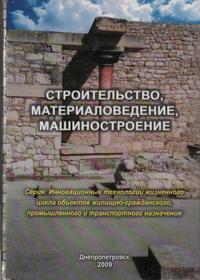An overview of modern methods of maximizing project profits (foreign experience)
Keywords:
project, analysis, ChTPAbstract
The review and analysis of existing foreign methods and models considering the establishment of rational plans for the implementation of projects (programs) provided maximization of the LDP using the network models of arc-node and arc-robot types are presented.
References
Baroum S.M. An Exact Solution Procedure for Maximizing the Net Present Value of Resource-Constrained Projects: Indiana University, 1992.
Baroum S.M., Patterson J.H. A Comparative Evaluation of Cash Flow Weight Heuristics for Maximizing the Net Present Value of a Project: King Abdul Aziz University, June 1993.
Buss A.H., Rosenblatt M.J. Activity Delay in Stochastic Project Networks: Washington University, November 1993.
Dayanand N., Padman R. On Modeling Progress Payments in Projects: Carnegie Mellon University, December 1995.
Demeulemeester E., Herroelen W., Van Dommelen P. An Optimal Recursive Search Procedure for the Deterministic Unconstrained Max-npv Project Scheduling Problem: Department of Applied Economics, K.U. Leuven, 1996.
Dixit A.K., Pindyck R.S. Investment under Uncertainty: Princeton University Press, Princeton, New Jersey, 1994.
Doersch R.H., Patterson J.H. Scheduling a Project to Maximize its Present Value: A Zero-One Programming Approach – Management Science, 23, 1977. – pp.882-889.
Icmeli O., Erengii S.S. A Tabu Search Procedure for Resource Constrained Project Schedule to Improve Project Scheduling Problems with Discounted Cash Flows – Computers and Operations Research, 21, 1994. – pp. 841-853.
Icmeli O., Erengiic S.S. A Branch and Bound Procedure for the Resource Constrained Project Scheduling Problem with Discounted Cash Flows: Cleveland State University, July 1995.
Ozdamar L., Ulusoy G., Bayyigit M. A Heuristic Treatment of Tardiness and Net Present Value Criteria in Resource Constrained Project Scheduling: Department of Industrial Engineering, Marmara University, October 1994.
Padman R., Smith-Daniels D.E. Maximizing the Net Present Value of Capital Constrained Projects: An Optimization-Guided Approach: Camegie Mellon University, September 1993a.
Russell A.H., Cash Flows in Networks – Management Science, 16, 1970. – pp.357-373.
Russell R.A. A Comparison of Heuristics for Scheduling Projects with Cash Flows and Resource Restrictions – Management Science, 32, 1986. – pp.291-300.
Sepil C., Kazaz B. Project Scheduling with Discounted Cash Flows and Progress Payments: Middle East Technical University, Ankara, 1994.
Smith-Daniels D.E. Summary Measures for Predicting the Net Present Value of a Project: College of St. Thomas, St. Paul, Minnesota, 1986.
Smith-Daniels D.E., Aquilano N.J. Using a Late-Start Resource-Constrained Project Schedule to Improve Project Net Present Value – Decision Sciences, 18, 1987. – pp.617-630.
Smith-Daniels D.E., Smith-Daniels V.L. Maximizing the Net Present Value of a Project Subject to Materials and Capital Constraints – Journal of Operations Management, 7, 1987. – pp.33-45.
Ulusoy G., Ozdamar L. A Heuristic Scheduling Algorithm for Improving the Duration and Net Present Value of a Project – International Journal of Operations and Production Management, 15, 1995. – pp.89-98.
Yang K.K., Talbot F.B., Patterson J.H., "Scheduling a Project to Maximize Its Net Present Value: An Integer Programming Approach – European Journal of Operational Research, 64, 1992. – pp.188-198.
Yang K.K., Tay L.C., Sum C.C., "A Comparison of Stochastic Scheduling Rules for Maximizing Project Net Present Value – European Journal of Operational Research, 85, 1995. – pp.327-329.
Downloads
Published
Issue
Section
License
Редакція Видання категорично засуджує прояви плагіату в статтях та вживає всіх можливих заходів для його недопущення. Плагіат розглядається як форма порушення авторських прав і наукової етики.
При виявлені у статті більш ніж 25% запозиченого тексту без відповідних посилань та використання лапок, стаття кваліфікується як така, що містить плагіат. У цьому випадку стаття більше не розглядається редакцією, а автор отримує перше попередження.
Автори, в статтях яких повторно виявлено плагіат, не зможуть публікуватися в усіх журналах Видавництва ДВНЗ «Придніпровська державна академія будівництва та архітектури».
Автори, які публікуються у цьому журналі, погоджуються з наступними умовами:
- Автори залишають за собою право на авторство своєї роботи та передають журналу право першої публікації цієї роботи на умовах ліцензії Creative Commons Attribution License, котра дозволяє іншим особам вільно розповсюджувати опубліковану роботу з обов'язковим посиланням на авторів оригінальної роботи та першу публікацію роботи у цьому журналі.
- Автори мають право укладати самостійні додаткові угоди щодо неексклюзивного розповсюдження роботи у тому вигляді, в якому вона була опублікована цим журналом (наприклад, розміщувати роботу в електронному сховищі установи або публікувати у складі монографії), за умови збереження посилання на першу публікацію роботи у цьому журналі.
- Політика журналу дозволяє і заохочує розміщення авторами в мережі Інтернет (наприклад, у сховищах установ або на особистих веб-сайтах) рукопису роботи, як до подання цього рукопису до редакції, так і під час його редакційного опрацювання, оскільки це сприяє виникненню продуктивної наукової дискусії та позитивно позначається на оперативності та динаміці цитування опублікованої роботи (див. The Effect of Open Access).

